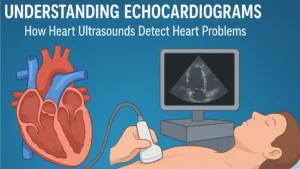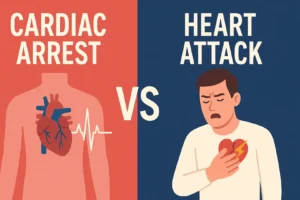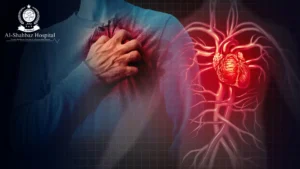Heart attacks are one of the most serious medical emergencies. It is the cause of most leading cause of death across the world. According to the World Health Organization (WHO), cardiovascular diseases claim an estimated 17.9 million lives each year globally, with heart attacks and strokes contributing over 80% of those deaths. In Pakistan, heart disease is responsible for 1 in every 4 deaths.
Making early detection more important than ever. And recognizing the early warning signs can mean the difference between life and death. With heart disease remaining the leading cause of death in the United States, understanding these critical symptoms is essential for everyone, regardless of age or health status.
What Is a Heart Attack?
A heart attack, or myocardial infarction, occurs when the blood flow to part of the heart is blocked, often by a blood clot. This deprives the heart muscle of oxygen, damaging the tissue and potentially leading to death if not treated urgently.
The Alarming Statistics: Why Heart Attack Awareness Matters
The statistics surrounding heart attacks are sobering and underscore the critical importance of recognizing early warning signs. According to the latest data from the Centers for Disease Control and Prevention (CDC) and the American Heart Association:
- Every 40 seconds, someone in the United States has a heart attack (CDC, 2024)
- One person dies every 34 seconds from cardiovascular disease (CDC, 2024)
- Approximately 805,000 heart attacks occur annually in the U.S., with 605,000 being first-time attacks and 200,000 being recurrent episodes (American Heart Association, 2024)
- As many as 1 in 5 heart attacks are “silent,” meaning they cause damage without obvious symptoms (American Heart Association, 2024)
- In 2023, 919,032 people died from cardiovascular disease, accounting for 1 in every 3 deaths (CDC, 2024)
These statistics highlight a crucial reality: heart attacks are not just a concern for the elderly or those with obvious risk factors. They can strike anyone at any time, making awareness of early warning signs vital.
Understanding Heart Attacks: What Happens in Your Body
Before diving into the warning signs, it’s important to understand what happens during a heart attack. Medically known as a myocardial infarction, a heart attack occurs when blood flow to a part of the heart muscle is blocked, usually by a blood clot. This blockage prevents oxygen-rich blood from reaching the heart muscle, causing tissue damage or death.
The most common cause of heart attacks is coronary artery disease, where fatty deposits (plaque) build up in the coronary arteries over time. When a plaque ruptures, it can form a clot that blocks blood flow, triggering a heart attack.
The 10 Early Warning Signs You Should Never Ignore
1. Chest Pain or Discomfort (Angina)
The Most Common Warning Sign
Chest pain remains the most recognizable and common early warning sign of a heart attack. However, it’s crucial to understand that heart attack chest pain doesn’t always present as the dramatic, crushing pain often portrayed in movies. 92% of heart attack patients report chest discomfort, but only 27% recognize it as a medical emergency. (CDC. Heart Disease Facts)
What to Look For:
- Pressure, squeezing, or fullness in the center or left side of the chest
- Pain that may come and go, lasting several minutes at a time
- Discomfort that feels like a heavy weight on your chest
- Burning sensation that might be mistaken for heartburn
- Tightness or constriction in the chest area
Important Note: Women are more likely than men to experience heart attacks without obvious chest pain, making it crucial to be aware of other symptoms.
2. Shortness of Breath (Dyspnea)
When Breathing Becomes Difficult
Shortness of breath is often one of the earliest warning signs of a heart attack and can occur with or without chest pain. This symptom occurs because the heart isn’t pumping efficiently, causing fluid to back up into the lungs.
What to Look For:
- Difficulty catching your breath during normal activities
- Feeling winded when walking short distances
- Breathlessness that occurs suddenly and without an obvious cause
- Feeling like you can’t get enough air
- Breathing difficulties that worsen when lying flat
3. Pain or Discomfort in the Upper Body
Beyond the Chest: Radiating Pain
Heart attack pain frequently radiates beyond the chest to other parts of the upper body. This referred pain occurs because the heart and other organs share nerve pathways 50% of women report non-chest pain symptoms like jaw and back pain as their first heart attack symptom. (Harvard Health. Women and Heart Attack)
Common Areas Affected:
- Arms: Particularly the left arm, but it can affect both arms
- Back: Often between the shoulder blades
- Neck and jaw: Especially the lower jaw
- Shoulders: One or both shoulders
- Upper abdomen: Sometimes mistaken for indigestion
4. Nausea, Vomiting, and Indigestion
Digestive Symptoms That Aren’t Always Digestive
Many people experiencing a heart attack report nausea, vomiting, or feelings similar to severe indigestion. These symptoms are more common in women and older adults.
What to Look For:
- Sudden onset of nausea without an obvious cause
- Vomiting, especially when accompanied by other symptoms
- Severe indigestion or heartburn that doesn’t respond to antacids
- Stomach pain or discomfort in the upper abdomen
- Feeling of fullness or bloating
5. Fatigue and Weakness
Unexplained Exhaustion
Unusual fatigue, particularly in women, can be an early warning sign of a heart attack that may appear days or weeks before the actual event. According to NHLBI. More than 70% of women who had a heart attack reported extreme fatigue days or weeks beforehand.
What to Look For:
- Sudden, overwhelming tiredness without an obvious cause
- Exhaustion that interferes with daily activities
- A weakness that’s different from normal tiredness
- Fatigue that doesn’t improve with rest
- Feeling drained after minimal physical activity
6. Dizziness and Lightheadedness
When the World Starts Spinning
Dizziness and lightheadedness can occur during a heart attack due to decreased blood flow to the brain as the heart struggles to pump effectively.
What to Look For:
- Sudden dizziness without an obvious cause
- Feeling faint or like you might pass out
- Lightheadedness when standing up
- Sensation of the room spinning
- Feeling unsteady on your feet
7. Cold Sweats
Perspiration Without Exertion
Breaking out in a cold sweat, especially when not physically active or in a warm environment, can be a significant warning sign of a heart attack.
What to Look For:
- Sudden, profuse sweating without physical exertion
- Clammy, cold skin
- Sweating that occurs along with other symptoms
- Perspiration that feels different from normal sweating
- Breaking out in a sweat during rest or mild activity
8. Rapid or Irregular Heartbeat
When Your Heart’s Rhythm Changes
Changes in heart rhythm, including palpitations, can be an early warning sign of cardiac distress.
What to Look For:
- Heart palpitations or fluttering
- Irregular heartbeat or skipped beats
- Rapid heart rate without an obvious cause
- Feeling like your heart is racing
- Unusual awareness of your heartbeat
9. Anxiety and Sense of Impending Doom
The Emotional Warning Sign
Many heart attack survivors report experiencing intense anxiety or a sense of impending doom before or during their heart attack. This psychological symptom shouldn’t be dismissed.
What to Look For:
- Sudden, intense anxiety without an obvious cause
- Feeling of impending doom or that something terrible is about to happen
- Panic-like symptoms
- Restlessness or agitation
- Feeling of being overwhelmed with fear
10. Sleep Disturbances
When Rest Becomes Elusive
Sleep disturbances, particularly in women, can be an early warning sign of heart problems that may precede a heart attack by weeks or months.
What to Look For:
- Sudden changes in sleep patterns
- Difficulty falling asleep or staying asleep
- Waking up frequently during the night
- Feeling unrested despite adequate sleep time
- Sleep disruptions without an obvious cause
Gender and Age Differences in Heart Attack Symptoms
Women’s Heart Attack Symptoms
Women are more likely to experience what are called “atypical” heart attack symptoms, which can make diagnosis more challenging:
- Less obvious chest pain: Women may experience pressure or tightness rather than crushing pain
- More upper body symptoms: Back pain, jaw pain, and neck pain are more common
- Digestive symptoms: Nausea, vomiting, and indigestion are more frequent
- Fatigue: Overwhelming tiredness is a significant warning sign in women
- Shortness of breath: Often, the most prominent symptom in women
Symptoms in Older Adults
Adults over 65 may experience different or more subtle symptoms:
- Silent heart attacks: More common in older adults, particularly those with diabetes
- Confusion or mental changes: May be the primary symptom in elderly patients
- Falls or sudden weakness: Can be the presenting symptom
- Less chest pain: Older adults may not experience typical chest pain.
Global & Pakistan Heart Health Statistics
| Metric | Data | Source |
| Global CVD deaths/year | 17.9 million+ | WHO |
| Pakistan heart disease deaths/year | 200,000+ | JPMA |
| Women without chest pain (heart attack) | 43% | Go Red for Women |
When to Seek Emergency Medical Care
Call emergency services Immediately If You Experience:
- Any combination of the symptoms listed above
- Symptoms that are severe, sudden, or different from normal
- Chest pain lasting more than a few minutes
- Shortness of breath with chest discomfort
- Symptoms that worsen over time
Don’t Wait – Time Is Heart Muscle
The phrase “time is muscle” is crucial in heart attack care. The sooner treatment begins, the better the chances of survival and recovery. Don’t drive yourself to the hospital – call 911 so that treatment can begin immediately.
Risk Factors for Heart Attack
Understanding your risk factors can help you be more vigilant about early warning signs:
Modifiable Risk Factors:
- High blood pressure
- High cholesterol
- Smoking
- Diabetes
- Obesity
- Physical inactivity
- Poor diet
- Excessive alcohol consumption
- Stress
Non-Modifiable Risk Factors:
- Age (risk increases with age)
- Gender (men are at higher risk at younger ages)
- Family history of heart disease
- Previous heart attack or stroke
- Ethnicity (some groups have a higher risk)
Prevention: Your Best Defense
While recognizing early warning signs is crucial, prevention remains the best strategy:
Lifestyle Modifications:
- Maintain a heart-healthy diet rich in fruits, vegetables, and whole grains
- Exercise regularly (at least 150 minutes of moderate activity weekly)
- Don’t smoke, and avoid secondhand smoke
- Limit alcohol consumption
- Manage stress through relaxation techniques
- Maintain a healthy weight
Medical Management:
- Regular blood pressure monitoring
- Cholesterol level checks
- Diabetes management
- Regular check-ups with healthcare providers
- Medication compliance as prescribed
The Importance of Acting Fast
Recent studies have shown that the average person waits 2-3 hours before seeking help for heart attack symptoms. This delay can be fatal. The American Heart Association emphasizes that treatment is most effective when started within the first hour of symptom onset.
What to Do During a Heart Attack:
- Call emergency services immediately.
- Chew an aspirin if you’re not allergic (helps prevent blood clots)
- Stay calm and rest
- Loosen tight clothing
- If trained, perform CPR if the person loses consciousness
Conclusion: Your Heart’s Early Warning System
Recognizing the early warning signs of a heart attack could save your life or the life of someone you love. With heart attacks occurring every 40 seconds in the United States, awareness of these symptoms is not just helpful – it’s essential.
Remember that heart attack symptoms can be subtle and may not always fit the classic description of crushing chest pain. Women, older adults, and people with diabetes are particularly likely to experience atypical symptoms. When in doubt, it’s always better to err on the side of caution and seek immediate medical attention.
Don’t ignore the warning signs your body is giving you. Your heart’s early warning system is sophisticated and reliable – learn to listen to it, trust it, and act on it quickly. In the case of a heart attack, minutes matter, and early recognition can make all the difference between life and death.
Why Choose Al Shahbaz Hospital for Heart Care?
Expert Cardiologists on duty 24/7
Cardiac ICU, Angiography & Emergency Facilities
Modern diagnostic tools like Digital ECG, Echo, and Stress Tests
Team trained at national and international cardiac centers
Book Online at: https://alshahbazhospital.com
Frequently Asked Questions
Q1: How long do heart attack symptoms typically last?
A: Heart attack symptoms can vary significantly in duration. Some people experience symptoms for minutes, while others may have symptoms that come and go over hours or even days. Chest pain during a heart attack typically lasts longer than a few minutes or goes away and comes back. If you experience any heart attack symptoms for more than 5 minutes, call 911 immediately.
Q2: Can you have a heart attack without chest pain?
A: Yes. Up to 20% of heart attacks are “silent” and don’t cause obvious chest pain. This is more common in women, older adults, and people with diabetes. These individuals may experience shortness of breath, nausea, fatigue, or other symptoms without significant chest discomfort.
Q3: What’s the difference between a heart attack and cardiac arrest?
A: A heart attack occurs when blood flow to part of the heart muscle is blocked, while cardiac arrest happens when the heart suddenly stops beating effectively. A heart attack can lead to cardiac arrest, but they are different conditions. During a heart attack, the person usually remains conscious, while cardiac arrest causes immediate unconsciousness.
Q4: Are heart attack symptoms different for men and women?
A: Yes, there are notable differences. Men are more likely to experience the “classic” crushing chest pain radiating to the left arm. Women are more likely to experience shortness of breath, nausea, vomiting, back pain, jaw pain, and overwhelming fatigue. Women’s symptoms are often more subtle and may be mistaken for other conditions.
Q5: Can young people have heart attacks?
A: While heart attacks are more common in older adults, they can occur at any age. Risk factors like family history, smoking, diabetes, high blood pressure, and drug use can increase the risk in younger people. Heart attacks in people under 40 are rare but not impossible, especially with certain risk factors.
Q6: What should I do if I think someone is having a heart attack?
A: Call 911 immediately. While waiting for help:
- Help the person sit down and rest
- Loosen any tight clothing
- If they’re conscious and not allergic, give them aspirin to chew
- Stay with them and monitor their condition
- If they become unconscious and you’re trained, perform CPR
- Don’t drive them to the hospital yourself
Q7: Is it safe to drive myself to the hospital during a heart attack?
A: No, never drive yourself during a heart attack. You could lose consciousness, have a cardiac arrest, or your condition could worsen, putting yourself and others at risk. Call 911 so that paramedics can begin treatment immediately and safely transport you to the hospital.
Q8: How accurate are the early warning signs mentioned in this article?
A: The warning signs mentioned are based on extensive medical research and are recognized by major health organizations like the American Heart Association and the CDC. However, symptoms can vary greatly between individuals. Some people may have different symptoms, and some may have very subtle signs. When in doubt, always seek medical attention.
Q9: Can stress cause heart attack symptoms?
A: Yes, severe emotional or physical stress can trigger heart attack symptoms and may even cause a heart attack in susceptible individuals. This is sometimes called “broken heart syndrome” or stress cardiomyopathy. Chronic stress is also a risk factor for heart disease. If you’re experiencing symptoms during stress, don’t assume it’s “just stress” – seek medical evaluation.
Q10: What’s the survival rate for heart attacks?
A: Survival rates have improved significantly over the decades. Currently, about 90% of people who have a heart attack survive if they receive prompt medical treatment. The key factor is how quickly treatment begins – the sooner medical care is received, the better the chances of survival and recovery.
Q11: Can taking aspirin prevent a heart attack?
A: Aspirin can help prevent heart attacks in some people by reducing blood clotting, but it’s not appropriate for everyone. Low-dose aspirin therapy should only be started under medical supervision, as it can increase bleeding risk. During a suspected heart attack, chewing an aspirin (if not allergic) can help, but this doesn’t replace emergency medical care.
Q12: What lifestyle changes should I make after learning about these warning signs?
A: Focus on heart-healthy lifestyle changes:
- Eat a diet rich in fruits, vegetables, whole grains, and lean proteins
- Exercise regularly (aim for 150 minutes of moderate activity weekly)
- Don’t smoke and avoid secondhand smoke
- Manage stress through relaxation techniques
- Maintain a healthy weight
- Limit alcohol consumption
- Get regular check-ups and know your numbers (blood pressure, cholesterol, blood sugar)









